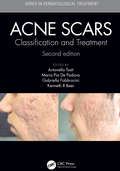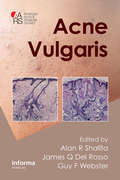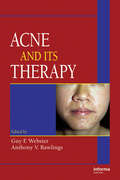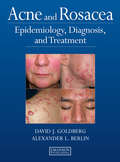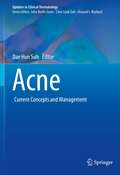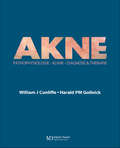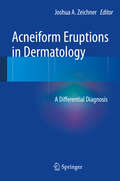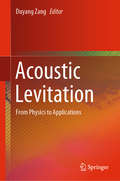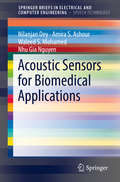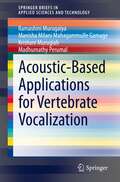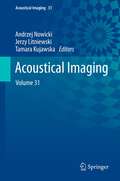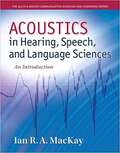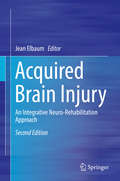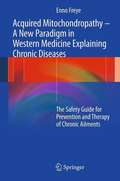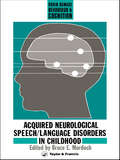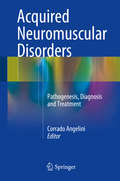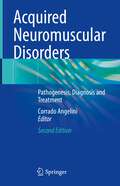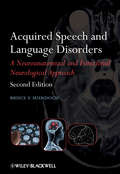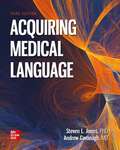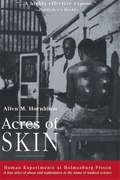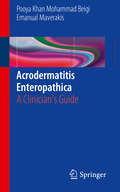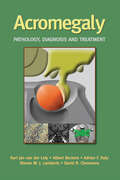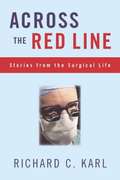- Table View
- List View
Acne Scars: Classification and Treatment, Second Edition (Series in Dermatological Treatment)
by Antonella Tosti Kenneth Beer Maria Pia De Padova Gabriella FabbrociniVisible scarring may be a daily reminder of disease long after active acne has subsided. Frequently, it is a cause of distress for the patient and a leading cause for visiting medical professionals. This updated and expanded edition of an acclaimed pioneering text will be invaluable for both general and cosmetic dermatologists, plastic surgeons, and primary care physicians with a specialist interest in the skin as an invaluable guide through the complexities of treatment.
Acne Vulgaris
by Alan R. Shalita Guy F. Webster James Q. Del RossoThe American Acne and Rosacea Society is dedicated to advancing the science related to acne and rosacea and to enhancing communication between those interested in these diseases. This text is not meant to be a comprehensive treatise on all aspects of acne, but rather to address major points of interest by acknowledged thought leaders in the field i
Acne and Its Therapy (Basic and Clinical Dermatology)
by Anthony V. Rawlings Guy F. WebsterAddressing one of the most commonly encountered conditions seen by the dermatologist, this source analyzes the pathophysiology, evaluation, diagnosis, clinical features, and control of acne. With full-color illustrations, this source delves into the available treatment options for difficult cases of acne and scarring and provides expert discussions
Acne and Rosacea: Epidemiology, Diagnosis and Treatment
by David Goldberg Alexander BerlinAcne, rosacea, and sebaceous hyperplasia are very common skin problems, which have a significant medical, cosmetic, and often psychological impact on the daily lives of millions of people. This book covers both the medical and cosmetic aspects of these skin disorders including all clinical considerations, etiology, epidemiology, diagnostic challeng
Acne: Current Concepts and Management (Updates in Clinical Dermatology)
by Dae Hun SuhThis book brings together world-famous acne researchers and specialists to compile a source of comprehensive, state-of-the-art information for management of acne. It examines acne as a chronic skin disease from pathogenesis to treatment. The book covers the clinical aspects of acne, topical treatments, light therapies, environmental factors and more alongside real patient photos from around the world. Treatments that chapters explore include photodynamic therapy and topical retinoids. In addition to genetic and hormonal causes of acne, chapters also include discussions on the connections between acne and diet, and acne and environmental factors. International contributors make this text unique in that it can focus solely on acne but also include international factors. Throughout the text, authors present the most up-to-date knowledge of acne pathophysiology, clinical features, differential diagnosis, treatment, and more. Pathophysiology, in particular, includes information on bacteria, immunity, endocrinologic factors, various deteriorating factors and environmental factors. As for clinical features, adult acne, differences in clinical patterns by region and race, and acne fulminans are covered. Regarding treatment, the latest knowledge on existing treatments or treatment methods, new drugs, and core outcome measures are mentioned. Acne: Current Concepts and Management is written for the dermatologist community from resident to researcher to privately practicing clinician.
Acne: Diagnose und Therapie
by William J Cunliffe Harald PM GollnickThis German edition includes updated results of clinical trials and provides a concise overview of acne, the various ways it presents and the optimum treatment of acne patients.
Acneiform Eruptions in Dermatology: A Differential Diagnosis
by Joshua ZeichnerDermatologists commonly treat acne, which affects 40 to 50 million Americans each year and about 85 percent of all patients at some point in their lives Dermatologists, primary care doctors, and pediatricians see these patients every day in practice It is important to treat the skin effectively not only to reduce the risk of physical scarring, but also to address the negative psychosocial impact this disease carries Improving the skin can improve self-confidence, interpersonal relationships, and performance in school or at work Acneiform Eruptions in Dermatology is a practical, full-color guide to the differential diagnosis of acne vulgaris and the treatment of acne-like conditions It is organized into sections by subtype of condition (e. g. , infections, genetic syndromes, medication-caused) and includes a section of variants of acne that may be misdiagnosed Within the sections, individual chapters discuss each variant of the condition and begin with a helpful bulleted summary of its defining clinical features Extensive color clinical images appear throughout the book.
Acoustic Communication in Animals: From Insect Wingbeats to Human Music (Bioacoustics Series Vol.1)
by Yoshimasa SekiThis book is the first volume of the bioacoustics series published by the Society for Bioacoustics. This volume provides an overview of the advances and recent topics in acoustic communication in various animals. Most animals produce vibrations and sounds by moving their body parts, including vocal organs. These sounds can be research targets of bioacoustics studies. How animals use these sounds, especially in inter-individual relationships, is the focus of this volume, “Acoustic Communication in Animals”. The authors’ expertise varies from molecular biology, neurobiology to psychology, and human brain imaging. Their research subjects range from invertebrates to humans. Despite the variety of topics, chapters are developed under the consideration of ethology and evolution. Readers will recognize the profundity of the topics in each chapter. In addition, the view and understanding of natural sound sequences produced by animals can vary among different cultures. Research from Japan and regions that have been underrepresented in previous literature can offer new ideas and unique perspectives in the study of bioacoustics. Readers can grasp the progress of this research field in a broad range of species in one book. The book presents multi- and interdisciplinary topics and appeals to researchers and students in fields including psychology, physiology, zoology, ethology, and neurosciences.
Acoustic Levitation: From Physics to Applications
by Duyang ZangThis book systematically introduces readers to the fundamental physics and a broad range of applications of acoustic levitation, one of the most promising techniques for the container-free handling of small solid particles and liquid droplets. As it does away with the need for solid walls and can easily be incorporated into analysis instruments, acoustic levitation has attracted considerable research interest in many fields, from fluid physics to material science. The book offers a comprehensive overview of acoustic levitation, including the history of acoustic radiation force; the design and development of acoustic levitators; the technology’s applications, ranging from drop dynamics studies to bio/chemical analysis; and the insightful perspectives that the technique provides. It also discusses the latest advances in the field, from experiments to numerical simulations. As such, the book provides readers with a clearer understanding of acoustic levitation, while also stimulating new research areas for scientists and engineers in physics, chemistry, biology, medicine and other related fields.
Acoustic Sensors for Biomedical Applications (SpringerBriefs in Speech Technology)
by Nilanjan Dey Amira S. Ashour Nhu Gia Nguyen Waleed S. MohamedIn this book, application-related studies for acoustic biomedical sensors are covered in depth. The book features an array of different biomedical signals, including acoustic biomedical signals as well as the thermal biomedical signals, magnetic biomedical signals, and optical biomedical signals to support healthcare. It employs signal processing approaches, such as filtering, Fourier transform, spectral estimation, and wavelet transform. The book presents applications of acoustic biomedical sensors and bio-signal processing for prediction, detection, and monitoring of some diseases from the phonocardiogram (PCG) signal analysis. Several challenges and future perspectives related to the acoustic sensors applications are highlighted. This book supports the engineers, researchers, designers, and physicians in several interdisciplinary domains that support healthcare.
Acoustic-Based Applications for Vertebrate Vocalization (SpringerBriefs in Applied Sciences and Technology)
by Ramashini Murugaiya Manisha Milani Mahagammulle Gamage Krishani Murugiah Madhumathy PerumalAcoustic-Based Applications for Vertebrate Vocalization is designed to help researchers improve their findings and knowledge of vertebrate vocalization by focusing on the integration of acoustic features with new technologies, such as the Internet of Things (IoT), cloud computing, and virtual and cognitive reality. The book addresses the most common challenges in vertebrate vocalization-based research via suitable audio signal processing techniques, data collection, data pre-processing, acoustic feature engineering, extraction, and selection for multidisciplinary applications, i.e. feature classification, vertebrate communication, behavioral analysis, and signal pattern analysis. The book is an important reference for scholars, researchers, industry practitioners, teachers, and students across a number of disciplines, including bioengineering, audio engineering, systems engineering, biotechnology, signal processing, biology, zoology, and animal sciences.
Acoustical Imaging: Volume 31 (Acoustical Imaging #31)
by Andrzej Nowicki Jerzy Litniewski Tamara KujawskaThe International Symposium on Acoustical Imaging is a unique forum for advanced research, covering new technologies, developments, methods and theories in all areas of acoustics. This interdisciplinary Symposium has been taking place continuously since 1968. In the course of the years the proceedings volumes in the Acoustical Imaging Series have become a reference for cutting-edge research in the field. In 2011 the 31st International Symposium on Acoustical Imaging was held in Warsaw, Poland, April 10-13. Offering both a broad perspective on the state-of-the-art as well as in-depth research contributions by the specialists in the field, this Volume 31 in the Series contains an excellent collection of papers in six major categories: Biological and Medical Imaging Physics and Mathematics of Acoustical Imaging Acoustic Microscopy Transducers and Arrays Nondestructive Evaluation and Industrial Applications Underwater Imaging
Acoustics in Hearing, Speech and Language Sciences: An Introduction
by Ian MacKayAcoustics in Hearing, Speech, and Language Sciences: An Introduction gives readers a clear, comprehensive understanding of acoustics in the context of human communications through examples and analogies from everyday life or general experience. <p><p> Mathematically the book stops short of calculus, using inductive reasoning to present material that can be proven only with calculus, and presenting multiple examples of mathematical calculations, with very explicit steps. Included are Questions and Problems sections focusing on often-misunderstood areas; Closer Look sections reinforcing and strengthening understanding of the material; and non-conventional, but scientifically accurate explanations of certain phenomena.
Acquired Brain Injury: An Integrative Neuro-Rehabilitation Approach
by Jean ElbaumThis book presents a comprehensive interdisciplinary team approach to the rehabilitation of acquired brain injury (ABI) survivors. Medical and clinical specialists will receive a deeper understanding of not only each other’s roles but of their complementary functions in this field. Many case examples are provided, illustrating a wide range of challenges and stages of recovery. This edition features 3 entirely new chapters and multiple updated chapters by new and returning authors.Featured in the coverage: The role of Robotics in acquired brain injuryA comprehensive chapter on physical therapy in ABIOutstanding recoveries woven together by a video news producer who recovered from a meningioma State of the art updates on neurosurgery, neurology, physiatry, neuropsychiatry and neuro-optometry.Updated chapters on neuropsychology, speech-language and occupational therapies including new technology and approaches as well as evidence based practicesPsychosocial challenges and treatment following ABIThe importance of family as team membersPost rehabilitation options and experiencesAcquired Brain Injury: An Integrative Neuro-Rehabilitation Approach, 2nd edition provides clarity and context regarding the rehabilitation goals and processes for rehabilitation specialists, interdisciplinary students of neuro-rehabilitation as well as practicing clinicians interested in developing their knowledge in their field.
Acquired Mitochondropathy – A New Paradigm in Western Medicine explaining Chronic Diseases
by Enno FreyeThe book on Acquired Mitochondropathy offers a new perspective on the understanding and the treatment of chronic ailments. Addressing a new paradigm deemed necessary, since in one of every four adults in the western world chronic ailments are on the rise. Resulting from energy dysfunction of cellular organelles, the mitochondria, the most of the common symptoms the physician faces during medical consultation are presented. An increasing focus on chronic disabilities presents difficulties for the busy practitioner, since patients typically describe a complex pattern of discomfort, disability, and distress, with pain affecting physical, social, and psychological functioning, which have to be put in the proper perspective. Since clinicians must efficiently condense widely varied symptomatic descriptions into characteristic patterns to permit accurate diagnosis and implement effective treatment, this book serves as a useful educational resource for the healthcare provider.
Acquired Neurological Speech/Language Disorders In Childhood (Brain Damage, Behaviour And Cognition Ser.)
by Bruce E MurdochThe long-held belief that acquired aphasia in children is primarily of the non-fluent type has been challenged in recent years. This book discusses language problems arising from cerebro-vascular accidents occurring in childhood, and from other
Acquired Neuromuscular Disorders: Pathogenesis, Diagnosis and Treatment
by Corrado AngeliniThis book provides state of the art information on the pathogenesis, diagnosis, and treatment of a range of inflammatory, autoimmune, and idiopathic neuromuscular disorders. The opening section discusses the differential diagnosis of acquired myopathies based on clinical, electrophysiological, muscle biopsy, and serological criteria, with special focus on the role of electromyography and antibody testing. Each of the relevant clinical entities is then discussed in detail, the coverage including, for example, myasthenia gravis, polymyositis, immune-mediated neuropathies, multifocal motor neuropathies, amyotrophic lateral sclerosis, paraneoplastic neuropathies, and diabetic polyneuropathy. Clear guidance is provided on currently available treatments, with descriptions of the latest advances in physiotherapy, drug therapy, and respiratory care. Other features of this clinically oriented book are the inclusion of many illustrative case presentations and contributions by international authors from leading centers.
Acquired Neuromuscular Disorders: Pathogenesis, Diagnosis and Treatment
by Corrado AngeliniThis book provides a state-of-the-art overview of the pathogenesis, diagnosis, and treatment of a range of inflammatory, autoimmune, and idiopathic disorders. The opening section covers clinical tools with a particular focus on the role of electromyography and MRI imaging. The second section then presents the differential diagnosis of acquired myopathies based on clinical, electrophysiological, muscle biopsy, and serological criteria, discussing in detail relevant clinical conditions such as including myasthenia gravis, polymyositis, and statin myopathies. The third section examines acute and chronic immune-mediated neuropathies, multifocal motor neuropathies, amyotrophic lateral sclerosis, paraneoplastic diseases, and diabetic polyneuropathy, offering clear guidance on available treatments and descriptions of the latest advances in immunotheraphy, drug therapy, and physiotherapy. This clinically oriented book also includes numerous illustrative figures and contributions by international authors from leading centers.
Acquired Speech and Language Disorders
by Bruce E. MurdochIt is vital to have knowledge of the neuroanatomical structures and functional neurological mechanisms, which are disrupted in neurogenic speech/language, disordered persons in order to understand the speech/language deficits themselves.This book provides a comprehensive coverage of the neurological basis of both the clinically recognised forms of aphasia and the various motor speech disorders, in both children and adults. It also covers more recently recognised language disorders, such as Parkinsons and related diseases, right hemisphere damage, closed-head injury, dementia, etc. This is a perfect text for practitioners who need to understand the integration of neuroanatomy and functional neurology with the practice of speech-language pathology.
Acquiring Medical Language
by Steven L. Jones Andrew CavanaghAcquiring Medical Language approaches medical language not as words to be memorized but as a language to be learned. This text teaches students to break down words into their composite parts and exposes students to all the relevant information (the root, its meaning, its use), so they see how it relates to the other roots in the context of the body system.
Acres of Skin: Human Experiments at Holmesburg Prison
by Allen M. HornblumAt a time of increased interest and renewed shock over the Tuskegee syphilis experiments, Acres of Skin sheds light on yet another dark episode of American medical history. In this disturbing expose, Allen M. Hornblum tells the story of Philadelphia's Holmesburg Prison.
Acrodermatitis Enteropathica: A Clinician's Guide
by Pooya Khan Mohammad Beigi Emanual MaverakisThis new text provides insight and treatment options for the covered disease, including dozens of high quality photographs, illustrations, and clinical tables. Topics covered include the history of the disease, categories of the disorder, molecular analysis, epidemiology, effects on body systems, disorder symptoms, and treatment. Acrodermatitis Enteropathica is a rare disorder of zinc metabolism that occurs in one of two forms: inborn and acquired. If untreated, the disease is fatal and affected individuals may die within just a few years, but since there is no cure for the condition, it is critical that physicians are aware of the signs and symptoms related to AE and the appropriate treatments available for patients. A Comprehensive Guide to Acrodermatitis Enteropathica is the only book of its kind to give insight into this rare disorder. Written by and for dermatologists, pediatric specialists, and ObGYN's, this book contains one of the largest clinical research studies done on Acrodermatitis Enteropathica over the last decade.
Acromegaly: A Guide to Diagnosis and Treatment (Contemporary Endocrinology)
by Lewis S. Blevins Manish K. AghiReviewing the most current literature, this text is a guide to medical decision-making regarding the diagnosis and treatment of patients with acromegaly. The scope of the book is comprehensive, covering all relevant facets of acromegaly, beginning with a history of the disorder and a review of the somatotrophic axis. Etiology is then discussed, including growth hormone secreting pituitary adenomas and other neuroendocrine tumors. Subsequent chapters present imaging modalities and diagnosis via radiology and clinical findings, as well as comorbid symptoms such as sleep apnea, musculoskeletal considerations, cardiovascular disorders, cancer and diabetes. Both medical and surgical management chapters describe each in detail, including radiotherapy, transsphenoidal surgery, somatostatin analogues and dopamine agonists. Concluding chapters present long-term follow-up as well as an extended selected patient story detailing life with the disease.Bringing together the latest in endocrinologic and neurosurgical evidence and practice, Acromegaly will be the go-to resource for this challenging condition for years to come.
Acromegaly: Pathology, Diagnosis and Treatment
by Albert Beckers Aart Jan van der Lely Adrian Daly Steven W. Lamberts David R. ClemmonsThis book reviews the pathophysiology and physical manifestations of acromegaly and discusses the multiple treatment options now available for the management of the patient with acromegaly. The book contains an ample number of illustrations that help to emphasize points of particular interest, including radiological, histopathological, and physical
Across The Red Line: Stories From The Surgical Life
by Karl Richard C.Richard Karl, a doctor and teacher, takes the reader closer than any writer before into the corridors of the hospital, on the surgical table, and into the world of medicine. In these pages we see the tragedies and triumphs of modern medicine: the beauty of surgery done well, and the aftermath of operations that fail to deliver on the hopes of the doctor and patient. We witness the "M&M"—the morbidity and mortality meeting—where doctors scrutinize their own work and mistakes, and the often inevitable outcomes of treatment. Suffused throughout are Karl’s keen observations on the workings of the human body and its immense capacity for healing. ". . . I celebrate the rich privilege accorded the practicing surgeon. The surgical life is really about bearing witness to the human condition and about respecting the many almost whimsical variations of biology and about the intersection of the two. It is remarkable, really, the way I get to know people so intimately so quickly, and to observe the brave and often noble behavior in them, while I witness the relentless push of biology, the aging and decay, the growth and development, but most especially the healing, both physical and emotional. It is this natural drive of our bodies to repair themselves from all injuries (including the surgeon's wounds) that is the centerpiece of medicine. Without it no surgeon could cut. " Written with economy and subtlety, Across the Red Line offers a vivid picture of disease and the miracle of life. It will interest anyone who's ever been on either side of the surgical table.
